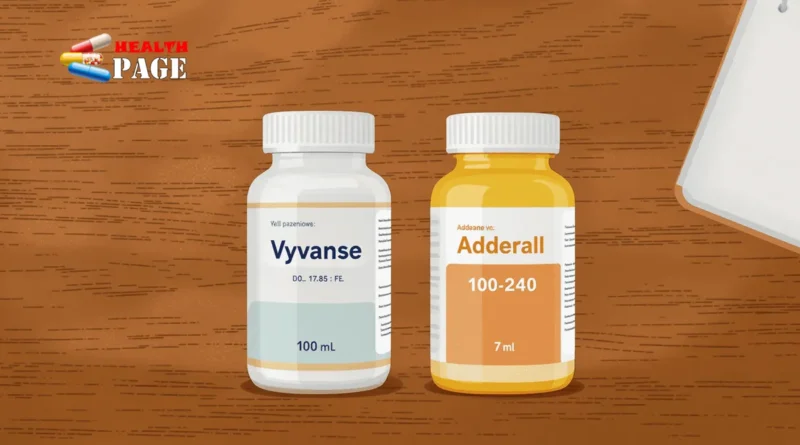7 Shocking Facts About What Is 40 mg of Vyvanse Equal to in Adderall
When it comes to understanding ADHD medications, it can often feel overwhelming. Two of the most commonly prescribed options are Vyvanse and Adderall, each with its own approach to managing symptoms.
While both medications are stimulants that aim to improve focus and attention, they have significant differences in how they are formulated and how they work. Vyvanse, being a newer medication, releases its active ingredient gradually throughout the day, providing a more controlled effect. On the other hand, Adderall offers immediate and extended-release forms, allowing for more flexibility in dosing.
Knowing how these medications compare in terms of dosage is important for:
- Achieving better control over your symptoms
- Reducing the likelihood of side effects
- Making informed choices about your treatment options
- Having productive conversations with your healthcare provider about medication changes
One common question that arises among patients and healthcare professionals is: “What is 40 mg of Vyvanse equal to in Adderall?” However, this comparison is not as simple as it may seem. Each individual’s response to medication can vary, and there are several factors that can influence how effective a particular drug will be.
In this article, we will explore seven surprising facts about Vyvanse and Adderall dosages. These insights will help you gain a better understanding of your medication choices and empower you to make informed decisions on your journey towards managing ADHD.
1. Vyvanse as a Prodrug: Understanding its Unique Mechanism
Vyvanse stands out in the ADHD medication landscape through its innovative prodrug formulation. Unlike traditional stimulants, Vyvanse remains inactive when first entering your body. The magic happens when your red blood cells interact with the medication, triggering a specific chemical process.
The Metabolic Process:
- Your body’s enzymes break down the lysine-drug bond
- This chemical reaction releases active dextroamphetamine
- The conversion occurs gradually throughout the day
- Your blood cells act as natural time-release mechanisms
This unique metabolic process creates a steady, controlled release of medication. Your body becomes a natural laboratory, converting Vyvanse into its active form at a consistent rate. The result? A smoother experience with fewer medication peaks and valleys.
Benefits of Gradual Onset:
- Reduced “roller coaster” effect common with instant-release medications
- Steady concentration levels throughout the day
- Lower risk of immediate side effects
- Decreased likelihood of rebound symptoms
The gradual onset characteristic of Vyvanse brings practical advantages for ADHD treatment. You’ll notice a gentler medication experience – no sudden jolts of energy or crashes. This steady-state approach helps maintain focus and attention throughout your daily activities.
Your body’s natural metabolism of Vyvanse creates predictable timing patterns:
- Initial effects begin: 1-2 hours after taking
- Peak effectiveness: 3-4 hours post-dose
- Duration of action: 10-14 hours
- Gradual tapering of effects
This metabolic process makes Vyvanse particularly suitable for students, professionals, and anyone needing consistent symptom management throughout their day. The prodrug mechanism delivers reliable performance without the sharp peaks and valleys associated with traditional stimulant medications.
2. Adderall Immediate-Release vs. Extended-Release: Duration Matters!
Adderall comes in two distinct formulations: Immediate-Release (IR) and Extended-Release (XR). Each version offers unique benefits for ADHD symptom management, with significant differences in their duration and release patterns.
Adderall IR Characteristics:
- Kicks in within 30-60 minutes
- Peak effects occur 2-3 hours after intake
- Effects last 4-6 hours
- Requires multiple doses throughout the day
- Provides quick symptom relief
- Allows flexible dosing schedules
Adderall XR Characteristics:
- Takes effect within 60-90 minutes
- Releases medication in two phases
- Effects last 10-12 hours
- Single daily dose
- Maintains steady medication levels
- Reduces “peaks and valleys” in symptom control
The IR formulation releases its active ingredients immediately upon ingestion, creating a rapid onset of effects. You might notice enhanced focus and concentration within the first hour. This quick action makes IR suitable for specific situations like morning routines or afternoon study sessions.
XR uses specialized beads with different release timings. Half the beads dissolve immediately, while the remaining portion releases gradually throughout the day. This dual-delivery system creates a smoother experience with fewer medication level fluctuations.
The choice between IR and XR impacts daily routines significantly. IR users typically take multiple doses – morning, afternoon, and sometimes evening. XR users benefit from a single morning dose, eliminating the need for mid-day medication administration at work or school.
Your lifestyle and specific ADHD symptoms play crucial roles in determining which formulation suits you best. Early morning productivity needs might favor IR, while full-day coverage requirements could make XR more appropriate.
3. Understanding the Dosage Equivalence Between 40 mg Vyvanse and Adderall

When comparing Vyvanse and Adderall dosages, we uncover intriguing insights into how well these medications work. Typically, a 40 mg dose of Vyvanse is roughly equivalent to 12-15 mg of Adderall IR (immediate-release), but this isn’t a fixed rule.
Factors Influencing Dosage Equivalence:
- How your body metabolizes medications
- Your unique body chemistry
- Any previous experiences with medications
- The time of day you take your medication
- Your eating habits and food intake patterns
It’s important to note that everyone’s response to these medications can vary greatly. Some individuals may find that 40 mg of Vyvanse has a stronger effect on them compared to 15 mg of Adderall IR, while others may experience the opposite reaction.
Common Side Effects at Equivalent Doses:
Here are some common side effects associated with Vyvanse and Adderall at their equivalent doses:
Vyvanse 40 mg:
- Effects gradually kick in
- Appetite suppression is smoother
- Energy levels remain consistent throughout the day
- Crash after the medication wears off is less pronounced
- Potential disruption in sleep patterns
Adderall IR 12-15 mg:
- Effects start quickly
- Noticeable changes in appetite
- Energy levels may vary throughout the day
- Distinct crash period after the medication wears off
- Possible earlier bedtime due to its shorter duration
The Importance of Duration in Dosage Equivalence
Duration of effects plays a crucial role in understanding dosage equivalence between Vyvanse and Adderall. While 40 mg of Vyvanse releases medication steadily over 10-14 hours, 12-15 mg of Adderall IR concentrates its effects within 4-6 hours. This means that if you’re taking Adderall, you might need multiple doses throughout the day to match the coverage provided by Vyvanse.
Individualized Approach to Dosage Adjustments
Your healthcare provider may adjust these standard equivalencies based on your specific needs. Factors such as your work schedule, academic demands, and daily routines can influence the optimal dosage balance for you.
Regular monitoring and open communication with your healthcare provider are essential in ensuring the most effective treatment approach for your situation. They may recommend adjustments to your dosage based on how well you’re responding to the medication and any specific challenges you’re facing.
The Non-Linear Relationship Between Dosage and Effectiveness
It’s important to understand that the relationship between dosage and effectiveness isn’t always straightforward. A higher dose doesn’t automatically guarantee better results.
Finding your optimal dosage often requires careful titration under medical supervision. This means that your healthcare provider will gradually increase or decrease your dosage based on how you’re responding to the medication.
By working closely with your healthcare provider and being open about your experiences, you can find the right balance that works best for you.
4. Shared Mechanisms and Common Side Effects: The Dopamine Connection!
Both Vyvanse and Adderall work by targeting specific neurotransmitters in your brain. These medications increase dopamine and norepinephrine levels, two crucial chemicals that affect:
- Attention span
- Focus
- Impulse control
- Motivation
- Reward processing
Your brain naturally produces these neurotransmitters, but people with ADHD often have lower baseline levels. When you take either medication, they work to:
- Block the reuptake of dopamine and norepinephrine
- Stimulate additional release of these neurotransmitters
- Enhance neural communication in key brain regions
The shared mechanism of action explains why both medications produce similar side effects. Common reactions include:
Physical Effects:
- Dry mouth
- Reduced appetite
- Increased heart rate
- Higher blood pressure
- Sweating
Mental/Emotional Effects:
- Insomnia
- Anxiety
- Mood changes
- Irritability
- Racing thoughts
The intensity of these side effects can vary based on:
- Individual brain chemistry
- Dosage levels
- Time of day taken
- Food intake
- Sleep patterns
- Other medications
Some users report that the gradual release of dopamine with Vyvanse creates a smoother experience compared to Adderall’s more immediate impact. This difference stems from Vyvanse’s prodrug formulation, which requires your body to convert the medication into its active form.
Your doctor might recommend specific strategies to manage these side effects, such as:
- Taking medication with food
- Adjusting dosage timing
- Staying hydrated
- Monitoring sleep patterns
- Regular check-ups for heart rate and blood pressure
Understanding these shared mechanisms helps explain why your body responds similarly to both medications, despite their different formulations and release patterns.
5. Misuse Potential: How Formulation Differences Play a Role
The distinct chemical structures of Vyvanse and Adderall create significant differences in their potential for misuse. Understanding these differences helps patients and healthcare providers make informed decisions about medication choices.
Vyvanse’s Built-in Safety Features
- Prodrug formulation requires metabolic activation
- Cannot be crushed or snorted effectively
- No immediate euphoric effects when tampered with
- Gradual release mechanism stays intact regardless of administration method
Adderall’s Structure and Accessibility
- Direct-acting amphetamine compound
- Immediate effects when taken as prescribed
- Can be manipulated for non-medical use
- Higher potential for dependency due to rapid onset
The chemical composition of Vyvanse acts as a natural deterrent against misuse. Your body needs to process the medication through your digestive system to convert it into its active form. This biological requirement makes it nearly impossible to achieve the rapid onset effects that typically drive medication misuse.
Risk Factors and Prevention
- Regular medication monitoring
- Secure storage practices
- Proper disposal of unused medication
- Open communication with healthcare providers
Adderall’s direct-acting nature makes it more susceptible to non-medical use. The immediate availability of its active compounds creates a higher risk profile for dependency and misuse patterns. This risk factor often influences prescribing decisions, particularly for patients with a history of substance use concerns.
Clinical Implications
- Healthcare providers consider misuse potential in prescription decisions
- Insurance companies factor abuse deterrence into coverage policies
- Treatment plans incorporate risk assessment strategies
- Regular evaluation of medication effectiveness and compliance
The formulation differences between these medications play a crucial role in their safety profiles. Your healthcare provider weighs these factors alongside your medical needs to determine the most appropriate treatment option.
6. Choosing Wisely: Individual Considerations in the Vyvanse vs. Adderall Debate
Selecting between Vyvanse and Adderall requires careful consideration of your specific needs and lifestyle factors. Here are key considerations to help guide your decision:
1. Daily Schedule Requirements
- Vyvanse offers consistent 10-14 hour coverage
- Adderall IR allows flexible dosing for shorter tasks
- Adderall XR provides intermediate coverage (10-12 hours)
2. Morning Routine Compatibility
- Vyvanse needs 1-2 hours to reach full effect
- Adderall IR acts within 30 minutes
- Your wake-up time and first daily tasks impact this choice
3. Side Effect Sensitivity
- Vyvanse’s gradual release reduces “peaks and valleys”
- Adderall’s quicker onset might cause more noticeable effects
- Individual tolerance varies significantly
4. Cost and Insurance Coverage
- Generic Adderall options are typically more affordable
- Vyvanse remains under patent protection
- Insurance formularies often influence medication access
5. Personal Response Patterns
- Some patients report better focus with one medication
- Individual metabolism affects medication effectiveness
- Previous experiences with similar medications matter
Your healthcare provider can help evaluate these factors against your specific symptoms, schedule, and medical history to determine the most suitable option for your ADHD management needs.
7. Practical Applications: Making an Informed Decision Between Vyvanse and Adderall!
Making a practical choice between Vyvanse and Adderall requires careful consideration of your daily routine and specific needs. Here’s a practical breakdown to guide your decision:
Daily Schedule Assessment
- Students might benefit from Vyvanse’s all-day coverage during long class schedules
- Professionals working irregular shifts could prefer Adderall’s flexible dosing options
- Parents managing household tasks might appreciate Vyvanse’s consistent coverage
Lifestyle Compatibility
- Morning routines: Vyvanse needs 1-2 hours to reach full effect
- Meal timing: Adderall IR allows for strategic dosing around meals
- Sleep patterns: Night shift workers might find Adderall’s shorter duration helpful
Symptom Management Strategy
- Track your peak productivity hours
- Document when symptoms typically intensify
- Note specific tasks requiring focused attention
Cost and Insurance Considerations
- Generic Adderall options can reduce expenses
- Insurance coverage varies between medications
- Prescription savings programs differ for each drug
Your daily activities and responsibilities play a crucial role in medication effectiveness. A detailed discussion with your healthcare provider about these practical aspects helps create a personalized treatment approach aligned with your specific needs and circumstances.
Conclusion
Choosing the right ADHD medication involves careful thought and professional advice. Understanding how 40mg Vyvanse compares to Adderall requires considering various factors that influence treatment success.
Key Takeaways:
- 40mg Vyvanse is usually equivalent to 12-15mg Adderall IR
- Vyvanse provides longer-lasting symptom control with lower risk of abuse
- Adderall offers flexibility with both immediate and extended-release options
- Individual responses may vary based on metabolism and personal needs
- Both medications work by targeting dopamine systems
Your journey to effective ADHD management depends on your specific situation, daily activities, and treatment objectives. The choice between Vyvanse and Adderall goes beyond just dosage equivalence – it’s about finding what works best for your lifestyle.
Remember these important points:
- Seek personalized advice from healthcare providers
- Keep track of how you respond to medication
- Take lifestyle factors into account when making your decision
- Stay informed about both medication options
- Focus on long-term success in treatment
Choosing the right medication gives you the power to manage ADHD symptoms effectively while preserving your quality of life. With a better understanding of these medications, you’ll be more prepared to take part in treatment decisions and achieve the best outcomes.
FAQs (Frequently Asked Questions)
What is the relationship between 40 mg of Vyvanse and Adderall dosage?
Generally, 40 mg of Vyvanse is approximately equivalent to 12-15 mg of Adderall immediate-release (IR). However, this equivalence can vary based on individual response and side effects.
How does Vyvanse’s prodrug nature affect its mechanism and benefits?
Vyvanse is a prodrug that is metabolized into dextroamphetamine in the body, leading to a gradual onset of effects. This gradual onset offers benefits for ADHD treatment by providing smoother symptom control and potentially reducing misuse risk.
What are the differences between Adderall Immediate-Release (IR) and Extended-Release (XR)?
Adderall IR provides shorter duration effects requiring multiple doses per day, while Adderall XR offers extended duration allowing once-daily dosing. The choice depends on symptom control needs and individual preferences.
What common mechanisms do Vyvanse and Adderall share, and what side effects might occur?
Both medications increase dopamine and norepinephrine levels in the brain to help manage ADHD symptoms. Common side effects include dry mouth, insomnia, and potential appetite suppression.
How do formulation differences influence the misuse potential of Vyvanse versus Adderall?
Vyvanse’s prodrug formulation leads to a gradual release of active medication, which may lower its misuse potential compared to Adderall that has immediate-release formulations more susceptible to abuse.
What factors should be considered when choosing between Vyvanse and Adderall for ADHD treatment?
Important considerations include duration of symptom control needed, side effect profiles, individual response variability, risk of misuse, and practical aspects like dosing convenience for all-day symptom management.


